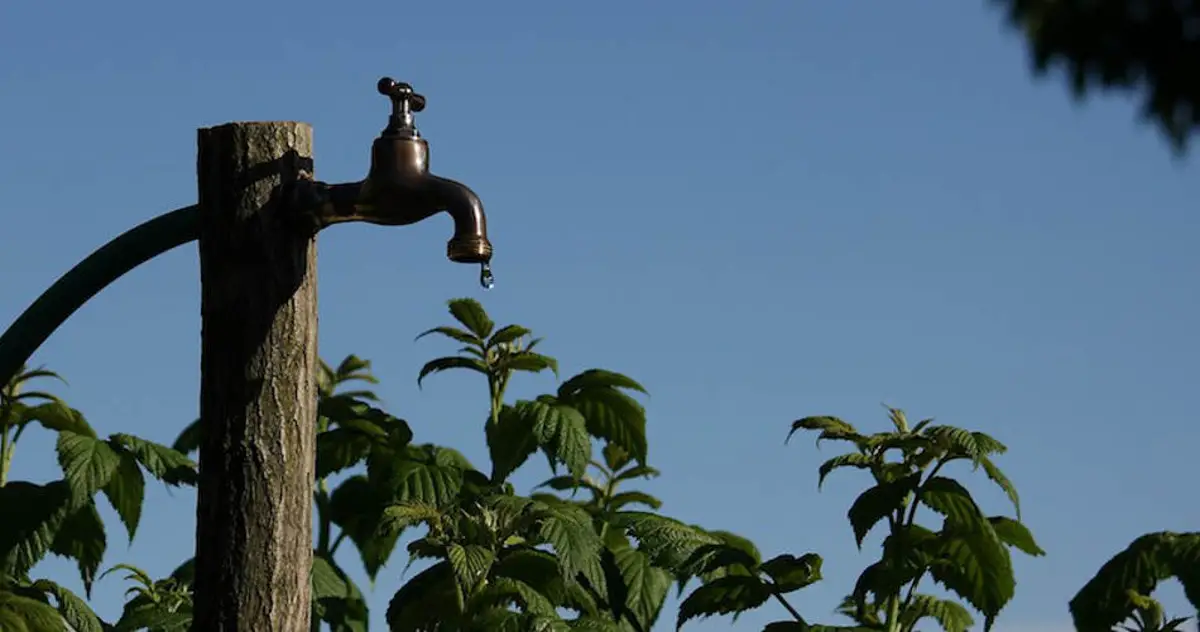For years I have been in the practice of saving water.
You never know when your source of water might be cut off.
Having sufficient water is the most critical need to be considered for Country or Homestead Property.
Several factors can effect the amount of water available even on land with a 5 gallon per minute well flow.
What if the water on the land is not enough for your needs?
Using grey water and collecting rainwater if legal in your area are two methods that can increase the water available on your property when there is insufficient well flow and no surface water from springs or streams.
First we will look at factors leading to a lack of sufficient water.
Then we will look at using grey water and collecting rain water as methods of increasing water availability.
Factors Leading To A Lack Of Sufficient Water
Periods of drought affect the output of wells, springs and the volume of water in streams and ponds.
The amount of rainfall and snow pack plays a role in next years well and spring water output.
Rain water and melted snow percolate down through the ground and raise the level of water in underground aquifers.
New wells drilled that take water from the same aquifer may cause all wells on that aquifer to produce less water.
By lowering the water level of the aquifer or decreasing the recharge rate of the wells.
Where there is insufficient water it will be late summer near peak harvest time when water availability becomes most critical.
Using Grey Water
Grey Water is water from the home that is not contaminated with human fecal waste.
This would be water from showers, sinks, bathroom vanities, and even clothes washing machines if a biodegradable detergent is used.
Grey Water does not include dishwater from a dish washing machine.
Commercial Dish Washing Detergents usually contain caustic additives.
And the water will have organic materials and fats the soap cleans off the utensils.
Grey Water can be used on gardens, berry bushes, watering fruit trees and to flush toilets.
Do not put Grey Water directly on fruits and vegetables, especially those eaten raw such as carrots.
Instead use it in gravity flow drip irrigation systems.
Or pour it directly on the ground near the base of plants or fruit trees.
Save your non-Grey Water to use when watering such garden produce as carrots, strawberries and other plants that are usually eaten raw.
Collecting Grey Water
Simple methods for collecting grey water might include catching water from sinks in a bucket when brushing teeth or washing face and hands.
Rinsing dishes with water in a dishpan instead of water in a sink to save the water in the dishpan would be another way to collect grey water.
By placing a bucket in the shower while waiting for the water to get warm is another way to collect water.
But the water collected while waiting for the shower water to get warm is not grey water .
So it could be used on anything that you would use clean water for.
Then while taking your shower you could collect the water in a different container as another method for collecting grey water.
Storing Grey Water
Grey Water can be stored in food grade 55 gallon drums that are metal.
Or plastic as long as they are stored where the water would not freeze during the winter.
A simple hand pump designed for use with a 55 gallon drum is an easy way to remove the stored Grey Water for use.
Cost Of Collecting And Storing Grey Water
The above described methods can be done for relatively little expense.
The Cost would be for a few buckets under sinks and in showers.
A dish pan for rinsing dishes.
A few 55 Gallon food grade drums and a hand pump to remove the stored Grey Water from the 55 gallon drums.
Depending on the family size, the cost could be as little as $100.00 to start.
Plumbing A House For Grey Water Collection
If building or remodeling a house, you can have it plumbed so that the grey water is collected in a separate (septic) tank.
This separate tank would be called the grey water tank.
Check with the Local Health Department to see if Local Building Codes prevent plumbing for Grey Water collection.
Be sure any grey water tank is buried below the frost line.
And that there is a way to remove the water from the tank.
Depending upon your situation this could be a simple hand pump or a more expensive solution.
All sink and shower drains would be plumbed to empty into the grey water tank buried below the frost line.
This grey water drain system is a separate drain system from the one used from toilets and from a dish washing machine.
I know of a house on the side of a hill where Grey Water was diverted to flow into a tank buried just below the house and uphill of the garden.
The Grey Water was used to water the garden at the bottom of the hill by gravity flow.
Collecting Rain Water
Another way to improve the water situation is to capture rainwater for use on the garden, orchard, berry bushes and water for the animals.
Some Western States have decided that a landowner collecting rainwater is illegal.
They claim ownership over rain, even if it falls on private property.
So check to be sure the State you live in allows landowners to collect rainwater.
The easiest way to collect rain water is from the roof using the gutters on your house.
It can be collected using 55 gallon food grade drums (barrels) that are either filled singly or connected together so that when one barrel is filled the overflow is sent to another barrel.
This method of collection works best in climates where it doesn’t get very cold in the winter.
This method can also be used to collect rain water in the spring, summer or fall to be used on the garden or watering stock.
A full 55 gallon barrel of water weighs around 400 pounds.
It may not be easy to move one to where it won’t freeze in the winter!
In northern climates you may want to consider burying an underground tank below the frost line and diverting the rain water from the gutters into the tank.
Collecting Clean Rainwater
To keep leaves, pine needles, dust and other debris out of your rainwater, you need a way of diverting water flow from your collection system.
Any simple method devised will work as long as it is easy to use.
Diversion of the first 15 minutes of rainwater is usually sufficient to remove pine needles, dust and debris that have collected on the roof from the stored rainwater.
Rain Water is safe to use as drinking water for stock animals and if filtered is safe for human consumption.
For over 15 years we have used a Big Berkey water filter made by British Berkefeld to filter our drinking water.
This is a tested and proven water filter that is used world wide by British Special Forces and provides safe drinking water in all kinds of situations.
How Much Rainwater Can Be Collected?
The amount of rain water collected depends on the size of the roof you are collecting from and the volume of rainfall you get where you live.
How much rain water that is collected will vary from year to year.
There are 231 cubic inches in a U.S. Gallon.
So for every 1 inch of rainfall on a roof that is 100 square feet in area.
You could get about a 55 gallon barrel of rainwater after diverting the first portion to get rid of debris that was on the roof.
This is an estimate rather than an accurate calculation.
This is because it depends on how hard it is raining.
And if you were right there to open the diversion system.
And to close it when the debris was washed off the roof.
Also be aware that not all rain fall is hard enough to remove the debris that can collect on the roof.
If you have other structures such as a barn or shop, utilizing their roof to collect rainwater would increase your yield.
The water from a small shed’s roof can be diverted into one or more 55 gallon drums.
Diverting water from a barn’s roof might require a second buried tank for collection.
Cost Of Collecting Rainwater
Rain water collection has been practiced for at least 100 years.
Diversion of rain water into cisterns is a time honored practice in many parts of the world.
The cost of collecting rain water depends on the system you choose to use.
Costs would range from the price of 55 gallon barrels and your diversion system all the way up to the cost of purchasing and burying a plastic tank below the frost line and diverting water into it.
Check with Farm Supply Stores or Building Supply Stores for the price of plastic tanks that are suitable for burying underground.
Don’t forget there is the cost of removing the water from the buried tank.
In the U.S., Farm Supply Stores such as Tractor Supply and North 40 can be contacted to see about pump systems to remove grey water or rain water from underground tanks.
As with collecting grey water, a simple hand pump designed for use in 55 gallon drums can be used to remove the rain water from collection drums.
If you live on a hillside and your garden is downhill from your house, gravity flow combined with a drip irrigation system or soaker hoses can be inexpensive methods of using water from underground tanks.
Amount Of Water That Can Be Saved In A Year
If you were to just save the Grey Water from an average of 1 shower each day, 20-30 gallons, and also from one load of clothes a week washed in a top loading washer, 20-30 gallons, that would equal 160-240 gallons of grey water saved each week.
Or 8,320-12,480 gallons of grey water saved each year!
If you were able to collect rainwater from just 200 square foot of roof space, 100-110 gallons per rain fall and do this an average of once a month over a years period of time that equals 1,200 to 1,320 gallons a year.
Only saving the above amounts of grey water and rain water each year would yield between 9,540 and 13,800 gallons more of water each year to use on your homestead!
Much more grey water and rain water than these figures is possible to save each year.
And can make a big difference in the success of your Country or Homestead Property.
You can estimate the water needs for your homestead to determine how much water you would need for your family in my article, “Daily Homestead Water Needs (Determining Amounts Necessary).”
Related Questions
Do drilled wells run dry?
Yes, there are times when drilled wells run dry.
This can happen in a drought and when other wells are drilled into the same underground stream or aquifer reducing the amount of water available.
Sometimes a well can be drilled deeper to solve the problem.
How long does a well last?
This depends upon several factors.
One of the most critical factors is the amount of water removed from the aquifer.
Compared to the amount of water that refills the aquifer from rainfall and snow melt.
Another factor is the dept of the water in the aquifer.
The deeper the aquifer the longer, in theory, it should provide water.
In the eastern U.S. where there is more rainfall a well can last a lifetime or longer.
In the western U.S. where it is more arid a well should last for 20 to 30 years, sometimes longer.
Should I buy property without water on it?
Land without a proven source of water on it is worth $Zero as a homestead or farm.
If there is not a proven source of good quality water on the land either do not buy it or have the seller develop a proven source of water before buying the land.
You want a minimum of 5 gallons per minute well flow, especially if financing the land.
Much more can be learned in my article, “Financing Land – Undeveloped Land, Conventional Loan, Water.”
If the seller needs to develop a proven water source, you need to add the cost of the well to the price of land at Closing.
If it is not done you cancel the sale, get back your earnest money and the seller keeps the land.



